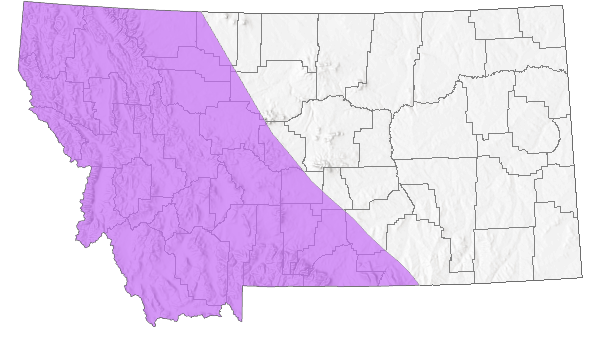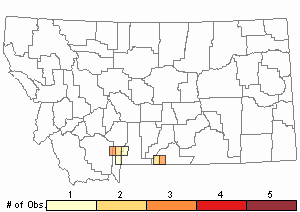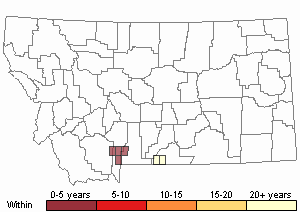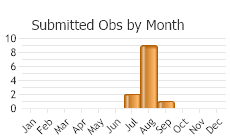View in other NatureServe Network Field Guides
NatureServe
Montana
Utah
Wyoming
Idaho
Wisconsin
British Columbia
South Carolina
Yukon
California
New York
Mead's Sulphur - Colias meadii
Native Species
Global Rank:
G4
State Rank:
S4
Agency Status
USFWS:
USFS:
BLM:
External Links
General Description
[From Ferris and Brown 1981; Curtis and Ferris 1985; Scott 1986; Opler and Wright 1999; Glassberg 2001] Forewing 1.9-2.7 cm. Wing fringes pink. Uppersurface burnt-orange with violet sheen, black border wide in males, fenestrated in females; males with distinct oblong sex patch at upper margin of hindwing. Undersurface of forewing with orange tinge and pale greenish border, hindwing green with small pink and simple-rimmed discal spot. White female form rare.
Phenology
One flight, July to August (Scott 1986). Mid-July to mid-August (Glassberg 2001). Late July to early September in the Rocky Mountain states (Ferris and Brown 1981), late June to early September in Colorado (Scott and Scott 1978), mid-July to early August in Idaho (Curtis and Ferris 1985), July and August in British Columbia (Guppy and Shepard 2001).
Diagnostic Characteristics
Best determined by a combination of pink wing fringes, uppersurface burnt-orange with wide black border, undersurface of forewing with orange tinge and pale greenish border, hindwing green with small pink and simple-rimmed discal spot.
Species Range
Montana Range
Range Descriptions

 Native
Native
Range Comments
The Rocky Mountains, from northern British Columbia and Alberta south in discontinuous regions to extreme northern New Mexico (Ferris and Brown 1981; Scott 1986; Opler and Wright 1999; Glassberg 2001; Guppy and Shepard 2001); 2896 m to 4145 m elevation in Colorado (Brown 1957; Scott and Scott 1978), 2438 m to at least 3383 m elevation in Wyoming (Nabokov 1953; Emmel et al. 1970; Curtis and Ferris 1985), 2438 m to at least 2774 m elevation in Idaho, 1628 m to 2500 m elevation in Alberta and British Columbia (Ferris 1972; Guppy and Shepard 2001). In Montana, reported from at least 15 counties in two regions (Glacier National Park-Bob Marshall Wilderness Complex, and southwestern Montana east to the Beartooth Mountains), at 2134 m to at least 3018 m elevation (Kohler 1980; Curtis and Ferris 1985; Stanford and Opler 1993; FLMNH Lepidopterists' Society database). Locally common to locally abundant (Glassberg 2001).
Observations in Montana Natural Heritage Program Database
Number of Observations: 19
(Click on the following maps and charts to see full sized version)
Map Help and Descriptions
Relative Density

Recency



 (Observations spanning multiple months or years are excluded from time charts)
(Observations spanning multiple months or years are excluded from time charts)
Migration
Non-migratory. Average dispersal distance for males 0.37-0.53 km, for females 0.26-0.7 km; longest 1.3 km (Watt et al. 1977), 1.7 km (Scott 1986).
Habitat
Alpine tundra, dry and lush subalpine meadows, willow bogs (Nabokov 1953; Ferris 1972; Curtis and Ferris 1985; Scott 1986; Opler and Wright 1999; Glassberg 2001; Guppy and Shepard 2001). In Glacier National Park, Montana reported above treeline in alpine terrain (Debinski 1993); in the Greater Yellowstone Ecosystem reported in high mountains at and near treeline (Debinski and Pritchard 2002).
Food Habits
Larval food plants are members of the pea family, including Astragalus (multiple species), Oxytropis, Trifolium (multiple species), and Vicea (Emmel et al. 1970; Scott and Scott 1978; Ferris and Brown 1981; Curtis and Ferris 1985; Scott 1986, 1992, 2006; Debinski and Pritchard 2002). Adults feed on flower nectar (including Achillea, Agoseris, Arnica, Erigeron, Haplopappus, Heterotheca, Hymenoxys, Oxytropis, Primula, Sedum, Senecio, Solidago, Symphyotrichum, Taraxacum), mud, and dew (Watt et al. 1974, 1977; Miller at al. 1994; Ezzeddine and Matter 2008; Scott 2014).
Reproductive Characteristics
Limited information. Females lay eggs singly on host plant leaves, usually on uppersurface but sometimes undersurface (Emmel at al. 1970; Scott 1986, 1992, 2006). Larvae feed on host plant leaves, hibernate as L3 or L4 instar, rarely as L5 instar; overwinters as L2-L3 instar in British Columbia, biennial in Alberta with L1 instar overwintering first winter and as mature larvae second winter (Scott 1979, 1986; Guppy and Shepard 2001). Apparently pupates on host plant (Scott 2006). Average adult male lifespan 6-7 days, adult females 4 days (Scott 1986). Males patrol throughout the day over all kinds of topography in open areas seeking females (Scott 1975b, 1986).
Stewardship Responsibility
References
- Literature Cited AboveLegend:
 View Online Publication
View Online Publication Brown, F.M. 1957. Colorado Butterflies. Proceedings; Numbers Three through Seven. Denver Museum of Natural History, Denver, Co.
Brown, F.M. 1957. Colorado Butterflies. Proceedings; Numbers Three through Seven. Denver Museum of Natural History, Denver, Co. Curtis, N.S. and C.D. Ferris. 1985. A review of Colias meadii W.H. Edwards with a description of a new subspecies from Idaho (Pieridae: Coliadinae). Bulletin of the Allyn Museum 91:1-0
Curtis, N.S. and C.D. Ferris. 1985. A review of Colias meadii W.H. Edwards with a description of a new subspecies from Idaho (Pieridae: Coliadinae). Bulletin of the Allyn Museum 91:1-0 Debinski, D. 1993. Butterflies of Glacier National Park, Montana. Occasional Papers of the Museum of Natural History, the University of Kansas, Lawrence, Kansas. No. 159: 1-13.
Debinski, D. 1993. Butterflies of Glacier National Park, Montana. Occasional Papers of the Museum of Natural History, the University of Kansas, Lawrence, Kansas. No. 159: 1-13. Debinski, D.M. and J.A. Pritchard. 2002. A field guide to the butterflies of the Greater Yellowstone Ecosystem. Lanham, MD: Roberts Rinehart Publishers. 107 p.
Debinski, D.M. and J.A. Pritchard. 2002. A field guide to the butterflies of the Greater Yellowstone Ecosystem. Lanham, MD: Roberts Rinehart Publishers. 107 p. Emmel, J.F., O. Shields, and D.E. Breedlove. 1970. Larval foodplant records for North American Rhopalocera Part 2. Journal of Research on the Lepidoptera 9(4): 233-242.
Emmel, J.F., O. Shields, and D.E. Breedlove. 1970. Larval foodplant records for North American Rhopalocera Part 2. Journal of Research on the Lepidoptera 9(4): 233-242. Ezzeddine, M. and S.F. Matter. 2008. Nectar flower use and electivity by butterflies in sub-alpine meadows. Journal of the Lepidopterists' Society 62(3): 138-142.
Ezzeddine, M. and S.F. Matter. 2008. Nectar flower use and electivity by butterflies in sub-alpine meadows. Journal of the Lepidopterists' Society 62(3): 138-142. Ferris, C.D. 1972. Notes on certain species of Colias (Lepidoptera: Pieridae) found in Wyoming and associated regions. Bulletin of the Allyn Museum 5:1-23.
Ferris, C.D. 1972. Notes on certain species of Colias (Lepidoptera: Pieridae) found in Wyoming and associated regions. Bulletin of the Allyn Museum 5:1-23. Ferris, C.D. and F.M. Brown (eds). 1981. Butterflies of the Rocky Mountains. Univ. of Oklahoma Press. Norman. 442 pp.
Ferris, C.D. and F.M. Brown (eds). 1981. Butterflies of the Rocky Mountains. Univ. of Oklahoma Press. Norman. 442 pp. Glassberg, J. 2001. Butterflies through Binoculars: A Field Guide to the Butterflies of Western North America. Oxford University Press.
Glassberg, J. 2001. Butterflies through Binoculars: A Field Guide to the Butterflies of Western North America. Oxford University Press. Guppy, C.S. and J.H. Shepard. 2001. Butterflies of British Columbia: including western Alberta, southern Yukon, the Alaska Panhandle, Washington, northern Oregon, northern Idaho, northwestern Montana. UBC Press (Vancouver, BC) and Royal British Columbia Museum (Victoria, BC). 414 pp.
Guppy, C.S. and J.H. Shepard. 2001. Butterflies of British Columbia: including western Alberta, southern Yukon, the Alaska Panhandle, Washington, northern Oregon, northern Idaho, northwestern Montana. UBC Press (Vancouver, BC) and Royal British Columbia Museum (Victoria, BC). 414 pp. Kohler, S. 1980. Checklist of Montana Butterflies (Rhopalocera). Journal of the Lepidopterists' Society 34(1): 1-19.
Kohler, S. 1980. Checklist of Montana Butterflies (Rhopalocera). Journal of the Lepidopterists' Society 34(1): 1-19. Miller, J., M. Litvak, S. Kelso, and A. Vargo. 1994. Comparative reproductive biology of two alpine primrose species. Arctic and Alpine Research. 26(3): 297-303.
Miller, J., M. Litvak, S. Kelso, and A. Vargo. 1994. Comparative reproductive biology of two alpine primrose species. Arctic and Alpine Research. 26(3): 297-303. Nabokov, V. 1953. Butterfly collecting in Wyoming, 1952. The Lepidopterists' News 7(2): 49-52.
Nabokov, V. 1953. Butterfly collecting in Wyoming, 1952. The Lepidopterists' News 7(2): 49-52. Opler, P.A. and A.B. Wright. 1999. A field guide to western butterflies. Second edition. Peterson Field Guides. Houghton Mifflin Company, Boston, Massachusetts. 540 pp.
Opler, P.A. and A.B. Wright. 1999. A field guide to western butterflies. Second edition. Peterson Field Guides. Houghton Mifflin Company, Boston, Massachusetts. 540 pp. Scott, J.A. 1975b. Mate-locating behavior of western North American butterflies. Journal of Research on the Lepidoptera 14:1-40.
Scott, J.A. 1975b. Mate-locating behavior of western North American butterflies. Journal of Research on the Lepidoptera 14:1-40. Scott, J.A. 1979. Hibernal diapause of North American Papilionoidea and Hesperioidea. Journal of Research on the Lepidoptera 18(3): 171-200.
Scott, J.A. 1979. Hibernal diapause of North American Papilionoidea and Hesperioidea. Journal of Research on the Lepidoptera 18(3): 171-200. Scott, J.A. 1986. The butterflies of North America: a natural history and field guide. Stanford University Press, Stanford, California.
Scott, J.A. 1986. The butterflies of North America: a natural history and field guide. Stanford University Press, Stanford, California. Scott, J.A. 1992. Hostplant records for butterflies and skippers (mostly from Colorado) 1959-1992, with new life histories and notes on oviposition, immatures, and ecology. Papilio new series #6. 185 p.
Scott, J.A. 1992. Hostplant records for butterflies and skippers (mostly from Colorado) 1959-1992, with new life histories and notes on oviposition, immatures, and ecology. Papilio new series #6. 185 p. Scott, J.A. 2006. Butterfly hostplant records, 1992-2005, with a treatise on the evolution of Erynnis, and a note on new terminology for mate-locating behavior. Papilio new series #14. 74 p.
Scott, J.A. 2006. Butterfly hostplant records, 1992-2005, with a treatise on the evolution of Erynnis, and a note on new terminology for mate-locating behavior. Papilio new series #14. 74 p. Scott, J.A. 2014. Lepidoptera of North America 13. Flower visitation by Colorado butterflies (40,615 records) with a review of the literature on pollination of Colorado plants and butterfly attraction (Lepidoptera: Hersperioidea and Papilionoidea). Contributions of the C.P. Gillette Museum of Arthopod Diversity. Fort Collins, CO: Colorado State University. 190 p.
Scott, J.A. 2014. Lepidoptera of North America 13. Flower visitation by Colorado butterflies (40,615 records) with a review of the literature on pollination of Colorado plants and butterfly attraction (Lepidoptera: Hersperioidea and Papilionoidea). Contributions of the C.P. Gillette Museum of Arthopod Diversity. Fort Collins, CO: Colorado State University. 190 p. Scott, J.A. and G.R. Scott. 1978. Ecology and distribution of the butterflies of southern central Colorado. Journal of Research on the Lepidoptera 17(2): 73-128.
Scott, J.A. and G.R. Scott. 1978. Ecology and distribution of the butterflies of southern central Colorado. Journal of Research on the Lepidoptera 17(2): 73-128. Stanford, R.E. and P.A. Opler. 1993. Atlas of western USA butterflies: including adjacent parts of Canada and Mexico. Unpubl. Report. Denver and Fort Collins, Colorado 275 pp.
Stanford, R.E. and P.A. Opler. 1993. Atlas of western USA butterflies: including adjacent parts of Canada and Mexico. Unpubl. Report. Denver and Fort Collins, Colorado 275 pp. Watt, W.B., P.C. Hoch, and S.G. Mills. 1974. Nectar resource use by Colias butterflies. Oecologia 14(4): 353-374.
Watt, W.B., P.C. Hoch, and S.G. Mills. 1974. Nectar resource use by Colias butterflies. Oecologia 14(4): 353-374.
- Additional ReferencesLegend:
 View Online Publication
View Online Publication
Do you know of a citation we're missing? Allen, T.J., J.P. Brock, and J. Glassberg. 2005. Caterpillars in the field and garden: a field guide to the butterfly caterpillars of North America. Oxford University Press.
Allen, T.J., J.P. Brock, and J. Glassberg. 2005. Caterpillars in the field and garden: a field guide to the butterfly caterpillars of North America. Oxford University Press. Brock, J.P. and K. Kaufman. 2003. Kaufman Field Guide to Butterflies of North America. Houghton Mifflin Company, New York, NY 284 pp.
Brock, J.P. and K. Kaufman. 2003. Kaufman Field Guide to Butterflies of North America. Houghton Mifflin Company, New York, NY 284 pp. Debinski, D. M. 1991. Inventory and monitoring of biodiversity: an assessment of methods and a case study of Glacier National Park, MT. Ph.D. Dissertation. Montana State University, Bozeman. 205 p.
Debinski, D. M. 1991. Inventory and monitoring of biodiversity: an assessment of methods and a case study of Glacier National Park, MT. Ph.D. Dissertation. Montana State University, Bozeman. 205 p. Forister, M.L., C.A. Halsch, C.C. Nice, J.A. Fordyce, T.E. Dilts, J.C. Oliver, K.L. Prudic, A.M. Shapiro, J.K. Wilson, J. Glassberg. 2021. Fewer butterflies seen by community scientists across the warming and drying landscapes of the American West. Science 371:1042-1045.
Forister, M.L., C.A. Halsch, C.C. Nice, J.A. Fordyce, T.E. Dilts, J.C. Oliver, K.L. Prudic, A.M. Shapiro, J.K. Wilson, J. Glassberg. 2021. Fewer butterflies seen by community scientists across the warming and drying landscapes of the American West. Science 371:1042-1045. Forister, M.L., E.M. Grames, C.A. Halsch, K.J. Burls, C.F. Carroll, K.L. Bell, J.P. Jahner, et al. 2023. Assessing risk for butterflies in the context of climate change, demographic uncertainty, and heterogeneous data sources. Ecological Monographs 93(3):e1584. https://doi.org/10.1002/ecm.1584
Forister, M.L., E.M. Grames, C.A. Halsch, K.J. Burls, C.F. Carroll, K.L. Bell, J.P. Jahner, et al. 2023. Assessing risk for butterflies in the context of climate change, demographic uncertainty, and heterogeneous data sources. Ecological Monographs 93(3):e1584. https://doi.org/10.1002/ecm.1584 Layberry, R.A., P.W. Hall, and J.D. LaFontaine. 1998. The Butterflies of Canada. University of Toronto Press. 280 pp. + color plates.
Layberry, R.A., P.W. Hall, and J.D. LaFontaine. 1998. The Butterflies of Canada. University of Toronto Press. 280 pp. + color plates. Watt, W.B., F.S. Chew, L.R.G. Snyder, A.G. Watt, and D.E. Rothschild. 1977. Population structure of pierid butterflies I. Numbers and movements of some montane Colias species. Oecologia. 27(1): 1-22.
Watt, W.B., F.S. Chew, L.R.G. Snyder, A.G. Watt, and D.E. Rothschild. 1977. Population structure of pierid butterflies I. Numbers and movements of some montane Colias species. Oecologia. 27(1): 1-22.
- Web Search Engines for Articles on "Mead's Sulphur"
- Additional Sources of Information Related to "Insects"





